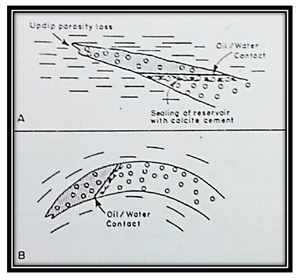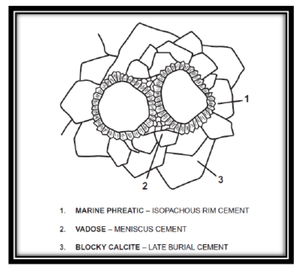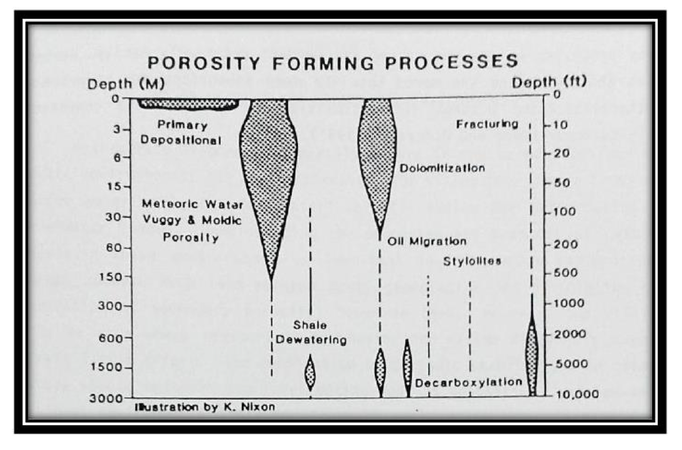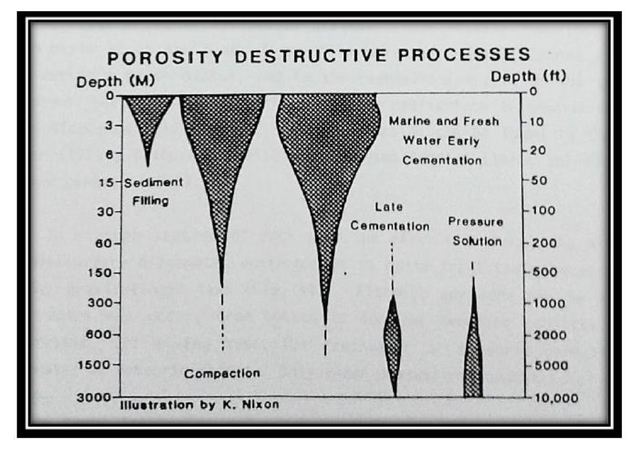Subsurface diagenesis and its relation with diagenetic trap on carbonate rocks reservoir
| Wiki Write-Off Entry | |
|---|---|

| |
| Student Chapter | Universitas Gadjah Mada |
| Competition | June 2015 |
Relation between subsurface diagenesis with porosity changing[edit]
Increase of porosity[edit]
Subsurface diagenetic process which produces or increases the porosity is dissolution and secondary porosity occurence. Rock dissolution in water saturated condition produces mold, vein, hole, and channel with or without the breakdown of this appearance (associated with cave and karst generally) and the solution which increases the interparticle porosity. This porosity type divides the origin generally and distinguishes the level based on the type. Generally, the origin shows the similar geological setting, where the porosity builds up and helps geologist to eliminate the unsuitable setting with dissolution. Geological setting where dissolution normally occurs is in the phreatic-meteoric zone, mixing zone, and vadose zone. Dissolution also may occur in the subsurface zone with rocks and water at the outside of chemical equilibrium.
The interaction between water and rocks where saturated fluide occurs, is causing a stable reaction which changing metastable carbonate or the other stable reaction (recrystallization, includes neomorphism). Weathering and soil formation process in the unconformity involves a combination of diagenetic process that is dissolution, precipitation, biological activity, and neomorphism. Soil and low weathering zone are not always important as the reservoir rocks, because the porosity size of matrix in carbonate is relatively small and have high capillary pressure.
General dissolution plays a role as corrosion and increasing porosity in lower burial setting. Lower burial dissolution is called mesogenesis dissolution, following Choquette and Pray[1] terminology, carbonate porosity classification (Mazullo and Harris, 1992). Saturation depends on CaCO3 in the fluide of burial because the fluide can be rich of CO2, H2S or organically acid. Burial dissolution makes the lower burial-carbonate reservoir to have porosity and permeability which can produce hydrocarbon, though standard “dogma” said that burial carbonate has 5% or low porosity. Increasing of porosity by the diagenetic dissolution produces size of pore with shape with that’s interconnected level widely.
Decreasing porosity[edit]
Decreasing with compaction[edit]
Mechanical compaction is resulted from overburden pressure during burial or from tectonics. Compaction causes exaggerated appearance when dissolution and compaction happen together and form stylolite when the pressure and dissolution is even. Graphic which shows decreasing pressure with increasing depth (Schmoker and halley, 1982) says that compaction plays bigger influence than cementation in decreasing porosity. Cementation happens during burial, so decreasing porosity and depth don’t have a function in a variable.
Compaction and cementation are important in decreasing porosity, because it can be known by calculating the number and type of the contact between grains in sample from different burial depth, so it can be used to estimate how far the compaction can decrease the original intergranular porosity. Rock with even contact within its grains and has some grain contacts in every area and lower porosity than uncompact rock where contacts are usually tangential and rare. If compaction plays more influence than decreasing porosity, there will be more contacts between grain with depth and contact will increase from tangential contact in shallow depth to stylolite contact in deep depth.
Because the compaction continues with pressure combination and dissolution, so stylolite will be formed. Generally, stylolite will be found more in mud-supported rocks (Dickinson and Saller, 1995) than in grainstone and packstone that generally decreases porosity and permeability (Nelson, 1981). Post-stylolite diagenesis may result porosity and permeability in light rocks (Dawson, 1988). Seismic and wireline log data can’t distinguish cementation, compaction, recrystallization, dissolution and replacement.
Decreasing with cementation[edit]
Cementation happens some times in carbonate rocks diagenesis, starts with cementation in marine environment after sedimentation until vadose environment, shallow, medium, and deep burial. Minerals and crystals will form carbonate cements that changes water chemically and depositional environment changes from marine phreatic to meteor phreatic or from shallow to deep below the surface.
Folk (1974) is one of scientists that explains about the importance of Magnesium (Mg), water salinity, and diagenetic environment (vadose, phreatic, or subsurface) as mineralogical control and crystal that form cement. The chronology and micro stratigraphy of cement can be known from the morphology of thin layers of cement. “Cement stratigraphy” shows what happens during burial diagenesis (Figure 1).
Because the result of burial and changed composition of water, mineralogy of cement and crystal are also changed. Changed composition of water during burial because of the migration to the mixture of water with in situ interstitial water which will go through various rocks-water reaction. Calcite, dolomite, and other minerals that form cement may be formed, depend on the composition of water and the equilibrium of every minerals. If calcite is formed, usually the shape is big.
Decreasing porosity from sementation can be identified by the cross-cutting relationship in “cement stratigraphy”. Isopachous cement with rim may be formed on early sementation in marine phreatic zone. Rougher cement may decrease more porosity. Residual effective porosity may be connected to poikilotopic cement that’s formed in deep burial environment. All cements may be crossed by joint that’s filled with mineral or burial-exotic deep cement. Exotic mineral cement and mineralized joints become the indicator of new permeability, followed by migration of mineralization fluid. Exotic fluid is generally associated with hydrocarbon migration and chances of forming new permeability is always as joint that’s formed after diagenesis process.
Scholle and Halley (1985) said that generally there’s just a little loss of porosity in zones near the surface water circulation (vadose, meteoric-phreatic, mixing zone). Transition of carbonate sediments are very porous and good cemented. Rocks with low porosity are dominated by subsurface processes. Scholle and Halley (1985) also explains about the important point of burial diagenesis. In reality, condition of fabric and texture sedimentation is combined together with early diagenetic processes like dissolution, cementation, and dolomitization that become the main factor which controls the distribution of subsurface porosity and permeability.
Longman (1980) clearly rejects the importance of burial diagenesis process such as compaction and cementation that decrease the volume of porosity and quality during burial of a sequence. Migration of hydrocarbon and filling of reservoir generally happen just well before compaction. In fact, compation and cementation can decrease the porosity in rocks near reservoir after finishing the migration of non-economic hydrocarbon.
Relation between porosity changes and depth[edit]
The question about in what depth that porosity of carbonate rocks formed seems like a simple question. But in fact, it’s impossible to calculate the relationship between porosity and depth.
The important point which showed from Figure 2 is :
- Many carbonate rocks porosity was formed at shallow-depth burial
- A few porosity was formed at more than a hundred meters depth cause the solution produce sthylolite not the pores at homegenic rocks. There are many exception where the burial dissolution in heterogenic rocks produce pores (Mazullo; Loucks and Budd, 1981)
- The cracking porosity can occurs in a certain depth but it’s seldom that more than a percents
In addition to relation of the porosity and depth forming, there are relationship between porosity break-up and depth. Figure 3. showing a main process of porosity break-up depends on the depth where it’s process occurs. These diagram is subjective, but can showing more of porosity breaking up thats occurs near the earth surface where the sediment submiting, thats have compaction and early cementation.
Process that can breaking up the porosity there are late-cementation which generally related with pressure solution at the same rocks or in adjacent and pressure solution which reducing the porosity by solution in grain contact or pore type changing along sthylolite. The important point from there are many porosity showed reduction at shallow depth by the easily predictable process. Porosity that forming at the shallow depth can moving to the deep subsurface may be preserve without sthylolitization. If there are occurs sthylolitization, the last cementation occurs generally. (Wong and Oldershaw, 1981)
Identification subsurface diagenesis that form diagenetic trap in carbonate rocks reservoir[edit]
Stratigraphic trap divided into two primary stratigraphic trap and secondary stratigraphic trap (Levorsen, 1954). Primary stratigraphic trap formed during deposition or diagenesis rock include formation of lens, facies changes and reef. Secondary stratigraphic trap is formed after deposition processes and diagenesis such as leaching and cementation but The main is unconformity.
The primary stratigraphic traps are a direct product of the deposition environment which is characteristic of the composition in the reservoir and the condition after deposition. Konkav upper surface on the trap has a effective pore cavities which is result of primary sedimentation process. This trap also called "depositional" trap and "diagenetic" trap.
There are two groups of primary stratigraphic traps in carbonate rocks which is essential to produce oil and gas. The first group form porous rocks facies either as lithofacies or biofacies surrounding shale, limestone or dolomite, as well as lenses containing residual carbonate organisms called biostrome. The second group in the form of porous or carbonate mound shaped lens consisting of mixture of in situ organisms and rock surrounding the so- called organic reef or bioherm.
One of stratigraphic traps which formed associated with subsurface diagenesis is porous carbonate facies. This trap group could evolve locally and regionally. The most common type is formed from the process dolomitisation where magnesium carbonate limestones deposited with less volume than the calcium carbonate replaced by a solution, resulting in porous and permeable rock.
In addition, the stratigraphic trap that can be influenced by subsurface diagenesis is a reef or bioherm (Landes, 1946). The main reason of oil production from some reef which rest on high porosity and high permeability reservoir rock. This porosity can be formed early or can be induced. Porosity early formed between the presence of abandoned spaces where the organisms life and the empty cavity between the outer wall shells on the set various organisms. While the induced porosity is generated from washing mass coral reefs by the circulation of water when approaching the surface, solution which exceeds precipitation during dolomitisation and can also be from reef fracture because the movement of the earth.
Diagenesis below the surface also has a relationship with the migration. When migration occurs early and precedes episodes of tilting or folding it takes prudence on the possible diagenesis trap (Wilson, H.H., 1975, 1977). Migration earlier indicated by some diagenesis carbonate sequences which suffered beforehand as cementation.

Figure 4 illustrates the sequence of events associated with diagenetic trap formation. In the example shows the mechanism original trapping with reduced porosity updip as a result of changes facies of grainstone oolitic into calcareous mudstone.
At the contact of oil / water in the reservoir is often precipitate calcite cement extensively. This phenomenon generally occurs in some carbonate reservoir which showed no evidence of cementation except in contact area of oil / water. The calcite cement occurrences associated with the reaction of sulfate reducing bacteria which can be explained in the following reaction (Friedman and Sander, 1978).
Formation water organic material calcite cement:
Generally calcite cement filled pore cavities at the contact of oil / water, trapping oil (sealing oil) between reservoir and reservoir formation impermeable here in after the movement of fluid. When cementation occurs extensively contact in the oil / water followed by a period of tilting or folding it no loss of oil from the reservoir and there is no transfer of oil to structural highs. When the trap diagenesa formed between rock sequences, exploration drilling on the structural highs will not succeed. To determine the location of potential diagenetic trap required sequence are not tilted or not bent by using information from seismic so that can be found trap earlier position that is covered by cementation at the contact of oil / water.
References[edit]
- ↑ Choquette, P. W. and L. C. Pray, 1970, Geologic nomenclature and classification of porosity in sedimentary carbonates: AAPG Bulletin, vol. 54, pp. 200-207
- ↑ Aquitaine, E., 1982, Exploration for Carbonate Petroleum Reservoirs: New York, John Wiley & Sons, Inc.
Other sources[edit]
- Ahr, W. M., 2008, Geology of Carbonate Reservoirs: United States: John Wiley & Sons, Inc.
- Anderson, T. F. and M. A. Arthur, 1983, Stable isotopes of oxygen and carbon and their application to sedimentologic and paleoenvironmental problems, in M. A. Arthur (Ed.), Stable Isotopes in Sedimentary Geology: SEPM Short Course No. 10
- Back, W., B. B. Hanshaw, T. E. Plye, L. N. Plummer, and A. E. Weidie, 1979, Geochemical significance of groundwater discharge and carbonate solution to the formation of Caleta Xel Ha, Quintana Roo: Mexico, Water Resources Res.
- Bathurst, R. G. C., 1975, Carbonate Sediments and their Diagenesis: New York, Elsevier Science Publ. Co.
- Bishop, M. G., 2000, South Sumatra Basin Province, Indonesia: The Lahat/Talang Akar- Cenozoic Total Petroleum System: U.S. Department of The Interior, U.S. Geological Survey
- Boggs, S., Jr., 1992, Petrology of Sedimentary Rocks: New York, USA, University of Oregon, Macmillan Publishing Company
- Boles, J. R. and G. Franks, 1979, Clay diagenesis in Wilcox sandstone of southeast Texas: implications of smectite diagenesis on sandstone cementation: J. Sediment. Petrol. 49
- Burst, J. R., 1969, Diagenesis of Gulf Coast Clayey Sediments and Its Possible Relation to Petroleum Migration: AAPG Bulletin, vol. 53, pp. 50-73
- Carpenter, A. B., 1978, Origin and chemical evolution of brines in sedimentary basins: Oklahoma, Geol. Surv. Circ. 79
- Chapman, R. E., 1983, Petroleum Geology: Amsterdam, Elsevier Science B.V.
- Choquette, P. W., and N. P. James, 1990, Limestones - The Burial Diagenetic Environment dalam Diagenesis: Canada, The Runge Press Ltd.
- Chilingarian, Mazullo, and Rieke, 1992, Carbonate Reservoir Characterization: A Geologic- Engineering Analysis, part I: Amsterdam, Elsevier Science B.V.



